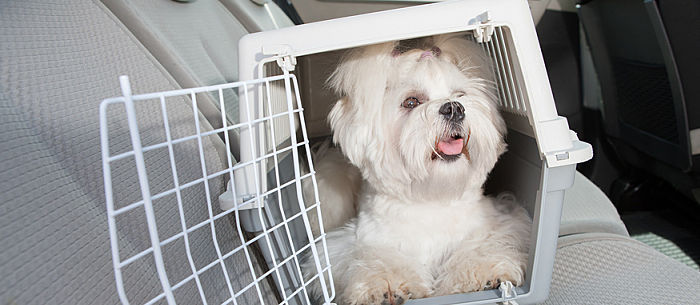Putting a dog in a crate may seem sad and isolating to many pet owners. However it is important to remember that dogs are instinctively denning animals, meaning that unless they’ve had a related traumatic experience in the past, they will not have negative feelings about being put in a confined area. In fact, dogs are naturally wired to seek out small den-like environments.
Here are 5 main benefits of crate training that will help both you and your dog.
- Serves as a Great Management Tool
You can use a dog crate in much the same way as you would use a playpen with a crawling baby: Think of it as a safe place to put your puppy for a short period of time. If your dog is overwhelmed by large groups or is still learning how to interact with others, you can put them in the crate when people come to visit. This will keep them safe and out of the way. - Lessens Anxiety at the Vets
When you board your dog or take them to appointments, they will have to spend time in a crate. If your dog already has some anxiety about being away or at the vet’s, and they aren’t crate trained, their anxiety will be even worse. Crate training at home can help your dog be more comfortable in these unfamiliar environments. - Good For Travel
Dogs can be a major distraction when you’re driving. They might walk around or even try to sit or stand on your lap. Using the crate when you travel in the car is safer than having your dog moving around. Crates are also useful when you take your dog with you on holiday. In this scenario, a crate can serve as a comfortable and familiar home away from home, which will help your dog feel less overwhelmed by new environments and the travelling process. - Facilitates House Training Efforts
Crates are ideal for house training because dogs don’t like to soil their sleeping place. This method allows you to learn your dog’s routine and continue training with consistency. If your dog is taken outside to urinate at the same time every day, they learns to expect that schedule and routine. Crates are also useful house training tools because they allow you to know your dog’s exact location. You need to know where your dog is at all times to prevent accidents. - Makes a Good Sleeping Area
Dogs, and puppies in particular, need lots of sleep. Puppies are a lot like children and can act up when they’re over tired. To make sure that your dog gets to sleep and stays asleep, you can move the crate to a quiet place during the evenings.
Puppies shouldn’t be in the crate for longer than four hours at a time. If you can’t be with your puppy for an entire eight- to 10-hour workday, you should arrange for a family member or dog sitter to take them out of the crate once or twice during this time period. Adult dogs can stay in the crate for longer periods of time. For older dogs, eight to 10 hours is generally considered the maximum time in a crate without a break to relieve themselves.
Your dog probably won’t be asleep for the entire time they are in their crate. As such, it is a good idea to provide them with their favourite toy, a comfy bed and an entertaining treat, to enhance their enjoyment of their crate. Remember, their crate is their home within your home.
